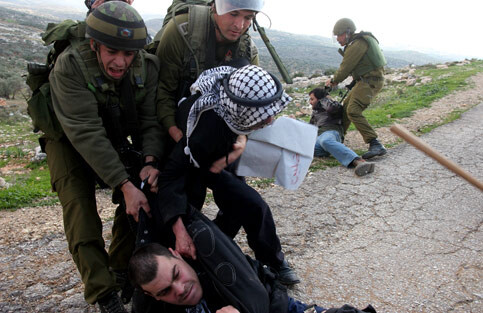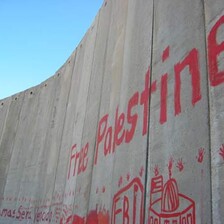The Electronic Intifada 15 August 2007

Israeli soldiers scuffle with Palestinian and foreign peace activists during a demonstration against Israel’s wall in the village of Bil’in, near the West Bank city of Ramallah, 12 January 2007. (Moti Milrod/MaanImages)
BIL’IN, West Bank, 13 August (IPS) - Amidst acres of twisting olive trees in front of the Israeli apartheid wall, eight protesters in a weekly nonviolent demonstration were injured and three arrested on Friday when Israeli occupation soldiers fired rounds of tear gas, smoke bombs, sound grenades and rubber bullets at the crowd in the West Bank village of Bil’in.
Five Palestinian children and a paramedic were also wounded as over one hundred protesters, including village residents, Israeli activists and international campaigners took part in a weekly demonstration that has been planned every Friday for more than two years.
Villagers first initiated the weekly demonstration in February 2005 when Israeli military forces began uprooting trees and leveling the terraced hillsides in preparation for the fence, an electrified and barbed-wired structure around the village severing hundreds of acres of agricultural land away from Bil’in farmers.
That land is now annexed to the wall which surrounds the Israeli settlement colony Modi’in Illit, housing approximately 33,000 Jewish-only settlers, making it the largest settlement colony in the occupied West Bank.
As the group of protesters descended down the hillside towards the wall, nearly a dozen Israeli soldiers waited under olive trees in front of several armored vehicles. Within minutes, the soldiers fired rounds of sound grenades and tear gas canisters at the protesters.
The crowd dispersed away from the soldiers, and turned around back up the hill, as the soldiers continued firing tear gas into the nearby trees. Some protesters remained behind, including some children who threw stones at the soldiers.
At that point, the Israeli soldiers began firing rubber-coated steel bullets that pierce and burn the skin, but when fired at close range can prove fatal.
“Every week, I come here,” a 19-year-old resident of Bil’in, who wanted his name withheld, told IPS. “When we come, the soldiers stop us and they use the gas, sound bombs and the rubber bullets. They use many kinds of weapons to stop the people, and the gas makes the people here very sick. There are many health problems now. And the [Israeli] settlers have shot us and beat us when we try to go to our land on the other side of the wall.”
In June of 2004, the International Court of Justice declared that “the construction and its associated regime was contrary to international law … Israel is under obligation to cease construction and dismantle the wall … Israel should compensate owners of land seized to construct the barrier and those harmed by the barrier … (and) all states are under obligation not to recognize the situation, and ensure Israel’s compliance with international law.”
Israel has said it will not accept the non-binding judgment, and has continued to construct the wall which upon completion will stretch 703 kilometers around the West Bank, oftentimes cutting deep across the Green Line — the internationally-recognized borders demarcated between Israel and Jordan in 1949.
Israel has stated that the purpose of the wall is to prevent suicide bomb attacks, but critics maintain that the underlying intention is to annex as much land as possible to the expanding Israeli settlement colonies inside the occupied West Bank.
Many small farming villages such as Bil’in, which are dependent on agricultural exports to both local and wider communities, have been extremely vulnerable to both economic and social decay after the building of the Israeli wall.
“If we look at the wall, which has confiscated some of the main resources for the Palestinian villagers — namely, the fertile land and the underground water tables — the economic and social structures in the Palestinian areas are changing very rapidly,” Jamal Jumaa, coordinator with the Palestinian Grassroots Anti-Apartheid Wall Campaign in Ramallah told IPS.
“Right now, 51 villages have been isolated from their agricultural land, and farmers who have been farming their land for generations are now having to find work in nearby cities or elsewhere. This has changed the society in general from agricultural-based to industrial-based.
“Behind the wall, Israel creates industrial zones. So you have Palestinians losing their land because of the wall and the settlements, then being forced to find work, becoming cheap labor for Israeli industry.”
Nonviolent protests against the encroaching apartheid wall have become a regular and daily occurrence across the West Bank, but in Bil’in, international activists too have maintained a visible presence at the weekly protests.
“The Israelis are trying to push how far they can go,” an elderly British-born US citizen who has joined the protesters told IPS. “And we have to say, ‘You’ve gone too far already.’ So we have to protest. And they are hoping the world will keep quiet. And people coming from all over the world here are showing that we won’t keep quiet. I’m from England, but I live in America where my tax dollars are paying for that [tear)] gas that just attacked me. So I’m paying for that. It’s an outrage.”
The 19-year-old said the Israeli military “hoped we would stop protesting and move out, but by doing these protests, we prove to them that we will stay here in our village.”
All rights reserved, IPS - Inter Press Service (2007). Total or partial publication, retransmission or sale forbidden.
Related Links




